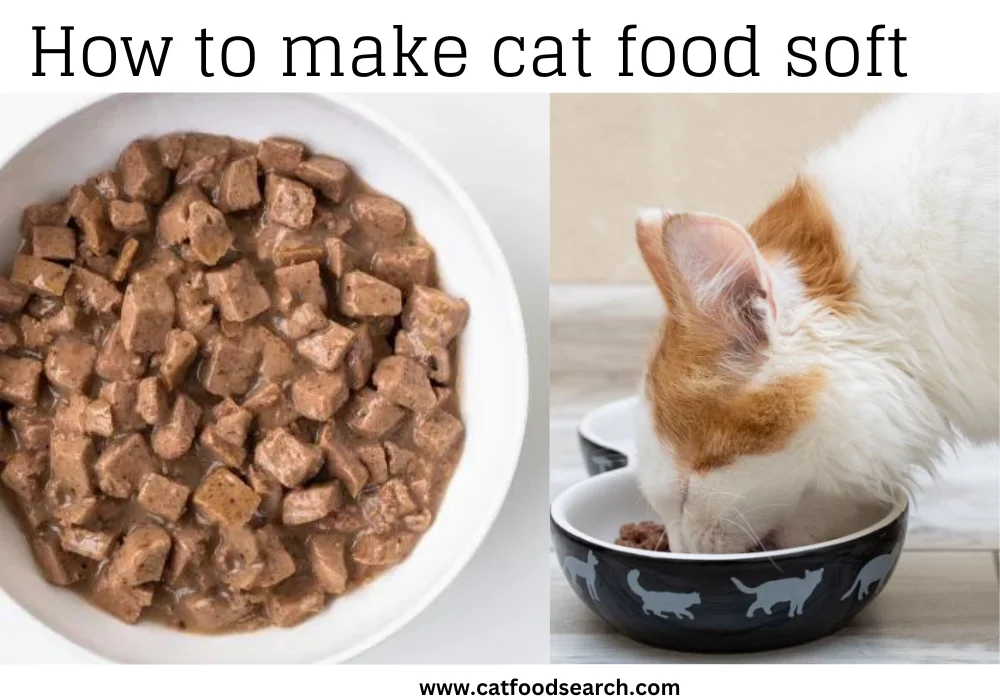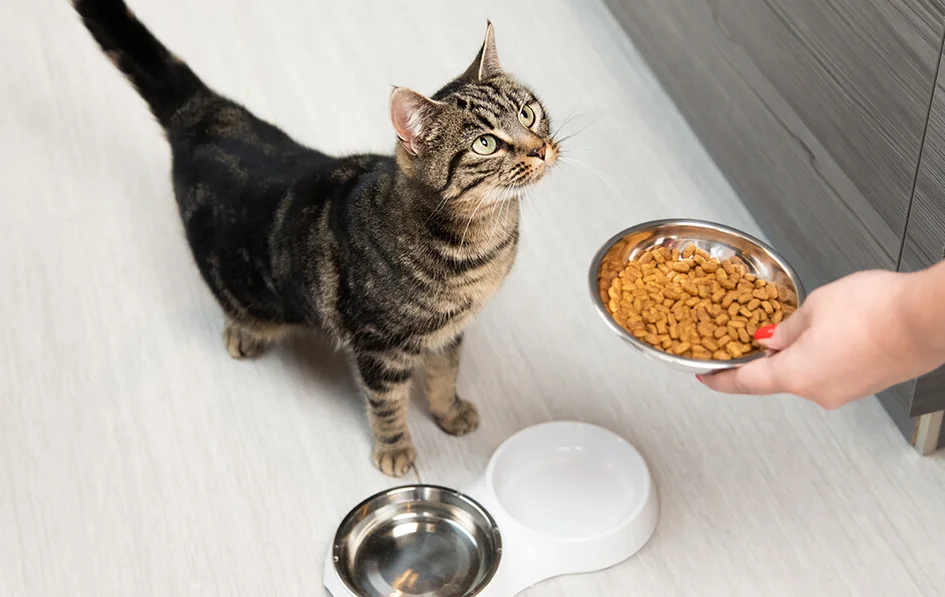As cat owners, we always want the best for our furry friends. From providing them with cozy beds to entertaining toys, we strive to keep them comfortable and content.
One crucial aspect of their well-being is their diet. Even though cats are known to enjoy crunchy kibble, there are instances when we need to soften their diet.
Soft cat food is essential to maintain our feline friends’ health and well-being. Some cats require a softer diet to meet their nutritional needs, Whether due to dental issues, age-related difficulties, or specific health conditions.
Whether it’s due to dental issues or a medical condition, ensuring that your cat’s food is soft and easy to eat is essential.
This article will cover a variety of techniques and advice for making cat food soft, ensuring that your feline friend gets the nutrition they require.

Table of Contents
The Importance of Soft Cat Food
When it comes to your cat’s health, the texture of their food plays a significant role. Softening their food can be necessary for several reasons, including:
1. Dental Problems: Like humans, cats can experience dental issues such as tooth decay, gum disease, or missing teeth. Softening their food makes it easier for them to chew and digest.
2. Senior Cats: As cats age, they may face age-related dental problems or decreased jaw strength. Soft food helps them maintain a balanced diet without straining their jaw.
3. Medical Conditions: Cats with medical conditions, such as oral inflammation or gastrointestinal disorders, may require a softer diet to prevent discomfort or exacerbation of their condition.
4. Post-Surgery or Injury: After undergoing dental surgery or sustaining a mouth injury, cats often need their food to be softened during healing.
Now that we understand the significance of soft cat food let’s explore various methods to make it a reality.
How to Make Cat Food Soft?
Making your cat’s food soft can be accomplished through different techniques. Here are some effective methods to ensure your feline friend enjoys their meals:
1. Moistening Dry Cat Food
One simple way to soften cat food is by moistening their regular dry kibble. Follow these steps to provide a softer texture for your cat:
➤ Start by measuring the appropriate amount of dry cat food according to your cat’s dietary needs.
➤ Place the measured kibble in a bowl.
➤ Gradually add warm water or low-sodium chicken broth to the bowl. Stir the mixture gently, allowing the kibble to absorb the liquid.
➤ Let the mixture sit for a few minutes until the kibble becomes soft and mushy.
➤ Check the temperature before serving to ensure it is not too hot.
2. Wet Cat Food
Wet cat food is already soft and easy to eat, making it an excellent option for cats with difficulty chewing. You can find many wet cat food options in pet stores or online. Look for high-quality brands that meet your cat’s nutritional requirements.
3. Homemade Soft Cat Food
If you prefer a more personalized approach, making homemade soft cat food gives you full control over the ingredients. Here’s a simple recipe to get you started:
Ingredients:
- Cooked boneless chicken or fish
- Cooked vegetables (e.g., carrots, peas)
- Cooked rice or mashed sweet potato
Instructions:
1. Shred the cooked chicken or fish into small, manageable pieces.
2. Mash the cooked vegetables until they are soft and easy to eat.
3. Mix the shredded meat, mashed vegetables, and cooked rice or mashed sweet potato together.
4. Ensure the mixture is well-blended and serve it at room temperature.
Remember to consult your veterinarian before introducing any homemade diet to ensure it meets your cat’s nutritional needs.
Feeding Tips for Cats on Soft Food
Feeding cats on a soft diet requires careful attention to portion control and nutritional balance. Here are some essential tips to ensure your cat receives the necessary nutrients while enjoying their meals:
Portion control
To calculate the right portion size for your cat’s age, weight, and activity level, refer to the feeding recommendations published by the cat food producer or veterinarian. Avoid overfeeding to prevent weight gain and associated health issues.
Monitor calorie intake
Soft cat food can be more calorie-dense than dry cat food. Monitoring your cat’s calorie intake is important to maintain a healthy weight.
Consult with your veterinarian to determine the ideal calorie range for your cat and adjust the portion sizes accordingly.

Transition gradually
When transitioning your cat from hard to soft food, do it gradually over several days.
Start by combining a little amount of the customary hard food with the soft meal, then gradually increase the proportion of the soft food while reducing the amount of the hard food. This gradual transition helps prevent digestive upset.
Balanced diet
Ensure that your cat’s soft food diet provides balanced nutrition. Consult with your veterinarian or a veterinary nutritionist to ensure that the soft food recipe or commercial option meets all the necessary nutritional requirements for your cat’s age, breed, and health condition.
Hydration
Soft cat food contains more moisture than dry food, which can contribute to your cat’s hydration. However, it’s still important to always provide fresh water to keep your cat properly hydrated.
By following these feeding tips, you can provide your cat with a nutritionally balanced and enjoyable soft diet.
How to Soften Dry Cat Food?
If you have dry cat food that you want to soften, here are a few methods you can try:
Add warm water
Pour some warm water over the dry cat food in a bowl. Let it sit for a few minutes to allow the kibble to absorb the water and soften. You can adjust the amount of water based on how soft you want the food to be.
Use wet cat food
Mix some wet cat food with the dry kibble. The wet food will help soften the dry food and make it more palatable for your cat. Gradually increase the proportion of wet food to dry food until your cat becomes accustomed to the new texture.
Add low-sodium chicken or vegetable broth
Instead of water, you can use low-sodium chicken or vegetable broth to moisten the dry cat food. The broth will add some flavor while softening the kibble. Just make sure the broth doesn’t contain any harmful ingredients to cats.
Let it soak overnight
If your cat prefers soft food, place the dry cat food in a bowl and cover it with water or broth. Let it soak overnight in the refrigerator. The kibble should be thoroughly softened and ready to serve by the next day.
Always monitor your cat’s food and ensure it is fresh and not spoiled. Additionally, consult with your veterinarian if your cat has specific dietary requirements or if you have concerns about their food texture.
Frequently Asked Questions
Can I make cat food soft by microwaving it?
It is generally not recommended to microwave cat food as it can create hot spots and alter the nutritional composition.
Are there any risks associated with soft cat food?
Soft cat food is generally safe for cats, but it’s important to ensure proper storage and handling to prevent bacterial growth.
Can I mix dry and wet food to make it softer?
Yes, mixing dry and wet cat food can help make the overall texture softer and more palatable for your cat. Gradually increase the proportion of wet food to achieve the desired consistency.
How often should I feed my cat soft food?
The frequency of feeding soft cat food depends on your cat’s age, health condition, and dietary requirements. Consult with your veterinarian for personalized feeding recommendations.
Can I Put Dry Cat Food in a Blender?
Yes, you can put dry cat food in a blender to make it easier for your cat to eat. However, it is essential to ensure that the texture is appropriate for your cat’s needs and that you do not alter the nutritional value of the food.
Can I Mix Dry Cat Food With Milk?
While it may seem tempting to mix dry cat food with milk, it is generally not recommended. Cats are lactose intolerant, meaning they lack the enzyme lactase required to digest lactose properly, the sugar in milk. Feeding cats milk can lead to digestive issues such as diarrhea, upset stomach, and gas.
Conclusion
Ensuring your cat’s food is soft and easy to eat is crucial for their health and well-being.
Whether you moisten dry food, provide wet food, or prepare homemade soft food, various methods are available to accommodate your cat’s needs.
By making cat food soft, you can accommodate your cat’s requirements, whether they have dental issues, health conditions, or prefer a softer texture.
Remember to monitor their portion sizes, maintain a balanced diet, and consult with professionals for personalized advice. You can ensure your feline companion enjoys their meals and stays healthy with proper care and attention.

Hi there! My name is Koushik; I am a cat lover. I specialize in writing about pet care & food. I have a wealth of knowledge on cat food niches and related subjects. I have worked in the pet industry for over 5 years and am passionate about helping cat owners provide the best care for their furry friends. With knowledge of cat food and nutrition, I aim to share their insights and help cat owners navigate the world of cat food niches. I enjoy playing with my two cats, reading, and exploring new cat food brands in my free time.
3 thoughts on “How to Make Cat Food Soft? 3 Amazing Methods”